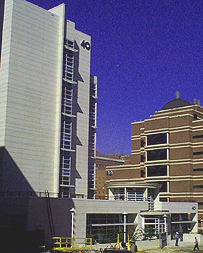
| T H E N I H C A T A L Y S T | S E P T E M B E R – O C T O B E R 2000 |
|
|
|
FROM THE GROUND UP:VRC TAKES ITS PLACE IN CAMPUS SKYLINE |
text
and photos by Fran Pollner |
 |
|
Almost
ready for prime time, the Vaccine Research Center now stands tall between
Building 49 (right–and actually across Convent Drive) and Building
37 (not shown).
|
In May of 1997, President Clinton declared that an AIDS vaccine should be developed within 10 years and that a new research center at NIH would be the ticket to getting the job done.
Over the next few months, NIH marshalled intramural and extramural forces to conceptualize the height, breadth, and depth of this project—the dimensions, both physical and scientific, of what began as a "center without walls." The resources to be amassed to generate AIDS vaccine candidates would be the bedrock as well for vaccine development in general. Scientists steeped in basic, translational, and clinical vaccine research would populate the labs. There would be on-site mini-vaccine–production facilities and off-site but nearby facilities for nonhuman primate studies.
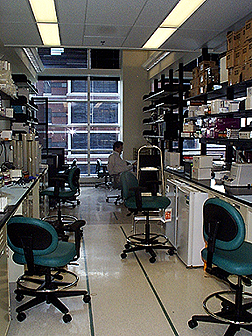 |
|
A
lab of one’s own:
The office space is adjacent to the lab space and lit by floor-to-ceiling
windows. Shown here is one of the several "bays" devoted to
VRC Director Gary Nabel’s lab. There are 10 such bays on each typical
VRC lab floor—and no doors. Four lab spaces and four office spaces
are contained within each bay, but the design allows for flexible rearrangements
based on each lab’s needs.
|
The speed with which the "center without walls" materialized into the state-of-the-art, five-story Vaccine Research Center—essentially completed when the photo above was taken at Catalyst press time in September—matched the urgency of the need the VRC was created to address.
Construction was begun in the fall of 1998, and in the spring of 1999 he cornerstone of the Dale and Betty Bumpers Vaccine Research Center, was dedicated in a ceremony attended by the president (see The NIH Catalyst, July–August 1999).
And a little more than one year later, although the first floor—housing the conference center, cybercafe, and director’s quarters—was still awash with construction workers, most of the four floors of labs and offices above was in working order.
The second week in September, VRC Director Gary Nabel moved into the building, taking up temporary administrative quarters on an upper floor and taking root in his new lab, where he and his team—which was moved from the University of Michigan, Ann Arbor, where Nabel had been director of the Center for Gene Therapy—resumed their research (see photo below). John Mascola and Mario Roederer—two new recruits—also moved into their respective labs and offices. In all, there were 20 researchers on site out of an anticipated 100 or so at full occupancy. (See NIH Catalyst, May-June 1999 for background stories on the VRC and Gary Nabel.)
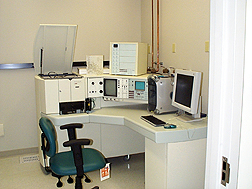 |
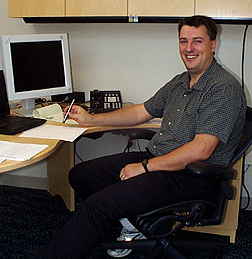 |
|
Flow
chart: Mario
Roederer, who spearheaded the development of 11-color flow cytometry at
Stanford and brought it with him to the VRC, will run the VRC’s Flow
Cytometry Lab (above; housed on the top floor, along with the BSL3 facility
and several other labs). Roederer has been examining the activities of
naive CD4+ T cells in AIDS progression.
|
Among people already named to key VRC positions are:
![]() Gordon Douglas,
director of strategic planning
Gordon Douglas,
director of strategic planning
![]() Barney Graham,
director for human clinical studies
Barney Graham,
director for human clinical studies
![]() Norman Letvin, director of the Non-Human Primate Research Program
Norman Letvin, director of the Non-Human Primate Research Program
![]() John Mascola,
VRC deputy director
John Mascola,
VRC deputy director
![]() Mario Roederer,
director of the Flow Cytometry Core Lab
Mario Roederer,
director of the Flow Cytometry Core Lab
Following are brief descriptions of these individuals, culled from more detailed biographical profiles that appeared in The NIH Record, July 25, August 8, and August 22.
Gordon Douglas, director of strategic planning, held academic and clinical positions in medicine and infectious diseases before joining the corporate world as an officer in Merck & Co. and president of Merck Vaccines. A primary focus for Douglas will be forging collaborations between the VRC, academia, and the pharmaceutical and biotechnology industries.
Barney Graham, director for human clinical studies and a tenured investigator, was a professor of medicine and associate professor of microbiology and immunology at Vanderbilt University School of Medicine in Nashville, Tenn. He helped establish NIAID’s AIDS Vaccine Evaluation Group, the network of centers that tests candidate AIDS vaccines in humans, and for the past 13 years headed Vanderbilt’s AVEG unit. Graham will shape the VRC’s clinical trials program. (For details of Graham’s research, see The NIH Catalyst, July–August 2000, "Recently Tenured.")
Norman Letvin, director of the Non-Human Primate Research Program, was immunology chairman at the New England Regional Primate Research Center of the Dana-Farber Cancer Institute in Boston before becoming chief of viral pathogenesis at Boston’s Beth Israel Deaconess Medical Center, a position he will maintain in conjunction with his VRC responsibilities. Letvin will choreograph the movement of vaccine candidates from VRC labs into nonhuman primate models.
John Mascola, VRC deputy director, headed HIV prevention research and had a lead position in HIV vaccine development at the Walter Reed Army Institute of Research in Washington, D.C. In addition o overall VRC planning, Mascola will oversee the basic and applied research activitiesconducted at the VRC’s biosafety level 3 facility.
Mario Roederer, director
of the Flow Cytometry Core Lab, did postdoctoral research in immunology at Stanford
(Calif.) University before becoming an adjunct associate professor of stomatology
at UCSF. At the VRC, Roederer will also continue his basic research on T-cell
subsets, antigen-specific immunity, and mucosal immunity. ![]()
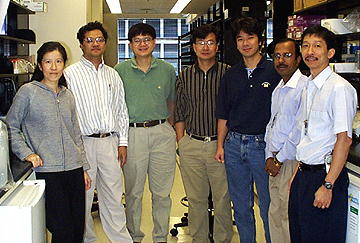 |
|
About
half of the Nabel lab:
(left to right) Ling
Xu, Yongnian
Sun, Zhi-Yong
Yang, Yue Huang, Masa Kurooka, Bimal
Chakrabarti, and lab manager Kwanyee
Leung. Some of the scientists have been in temporary quarters in Building
10 for about a year and are in various stages of transition to Building
40; others, like Nabel’s lab manager, who closed down the Michigan
lab August 31, came directly to the VRC and had been here only about two
weeks when this photo was taken. The team has been working on enhancing
the immunogenicity of selected HIV antigens, focusing especially on two
targets–gag pol and an envelope protein. Preliminary testing of mutants
of these proteins has yielded promising results in mouse models. This
research is proceeding in tandem with work on vector constructs.
|